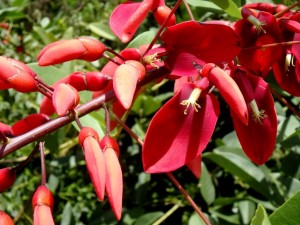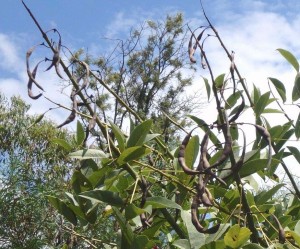Anomalous SST warming during MIS 13 in the Gulf of Lions (northwestern Mediterranean Sea)
By: Cortina, Aleix, Joan O. Grimalt, Belen Martrat, Andrés Rigual-Hernández, Francisco Javier Sierro, and José Abel Flores. Organic Geochemistry 92 (2016): 16-23. | Find with Google Scholar »
|
Dear all,
Thanks to everyone who came along to this week’s department meeting – there was a lot to get through so thanks for your patience. Next month’s meeting will be more leisurely I hope and allow some more discussion time. Put it in your diaries now – 1pm on March 2nd in the tearoom. This month’s meeting slides are here. Dept meeting 02Feb2016
A heads up that LIEF EoI applications to the Research Office are due next Friday 12 February – please let Mel Bishop know if you are applying for LIEF funding in this round.
We are advertising several positions in the department (see below) – please pass this on to anyone suitable you know who may be interested.
cheerio
Michelle
General News and Announcements
Positions in the Department
Lecturer
As Renee Catullo is moving to Western Sydney University, we are looking for a replacement. This is a fixed term (2 year) Level A teaching and research position and is available immediately. The teaching involves contributing to the coordination and delivery of a large first year introduction to molecular and cell biology unit (Biol115 ‘The Thread of Life) in the second semester of each year. Teaching materials from previous years will be provided and the unit will be co-taught with Dr Jennifer Hallinan. The ideal candidate will also have a clear research plan to achieve over the tenure of this fixed term, preferably in the areas of molecular evolution and molecular phylogenetics.
Application process: Please email an expression of interest consisting of a 1 page teaching statement (experience and philosophy), 1 page research statement (experience and future plan) along with a current CV to Michelle (michelle.leishman@mq.edu.au). Applications close March 4, 2016.
School Liaison Officer
The department plans to roll out a school outreach strategy in 2016 and we would like to appoint someone on a casual basis (7 hours per week) to be our school liaison officer. This would involve working with the department’s outreach committee to help develop and co-ordinate strategic school partnerships, including school visits and work experience programs.
Application process: Please send an expression of interest detailing your experience along with a current CV to Michelle (michelle.leishman@mq.edu.au). Applications close February 26, 2016.
Update Your University Contact Information
So that people can easily reach you, please update your contact information, especially if you have changed jobs, within the University, changed offices or office phone extension.
Email Signature
Follow this link to get a University template signature block
https://wiki.mq.edu.au/display/office365setup/How+to+add+staff+email+signatures+in+Outlook+Web+App
University Directory Information
Search for yourself on the University’s directory and update your contact information, if required.
Find the directory at the University’s staff webpage, http://staff.mq.edu.au/home/
Note that you will only appear on the University’s directory if you are paid, or have a position through HR.
2016 Parking Permits
Your 2016 Parking Permits are now available from Laura McMillan E8B204.
What you need is
- Car Registration number
- Car Make and Model
Stickers are only available from Laura through salary sacrifice for fixed term and continuing staff. HR will deduct 10 fortnightly amounts of $39.30.
Unfortunately, all casuals and students will need to obtain their stickers via the cashiers office and pay $393 (students $336) for a yearly or $220 (students $198) for half yearly upfront. Monthly permits may also be purchased from the cashiers office.
Your current stickers are still valid until the End of February 2016.
Teaching Technical Staff On Training – Unavailable
The teaching technical staff of Biological Sciences and CBMS will be on training and unavailable:
11th & 12th February from 9am to 1pm (two half days)
and
18th February – all day.
For emergencies that require a teaching technical staff member, please contact Rekha Joshi on 0409 561 213.
Val Williams Scholarship in Botany 2016
Applications are now being accepted from students undertaking scientific research at the Honours, Masters or PhD levels. Conditions apply, but the first criterion is that the research will contribute to the knowledge, conservation or propagation of native plants in the Sydney or surrounding regions.
The North Shore Group of Australian Plants Society NSW awarded the inaugural $2,000 scholarship in 2009 and since then nine scholars have used their scholarship money to augment their research. It will be maintained at $2,000 for our Eighth Round in 2016.
Our Scholarship honours the memory of the late Val Williams.
Application forms can be downloaded from our web site at http://www.blandfordia.org.au/Scholarship.html
Applications will close on 11th March 2016 and the successful applicant will be notified by 12th April 2016.
In addition, a complementary one-year membership of Australian Plants Society sponsored by Australian Plants Society NSW will be offered to the successful applicant.
Promised Baby Picture!
Introducing ‘little Prasanth’. He is gorgeous. Mum and dad are ok now. Congratulations Prasanth and Shwetha.
Volunteer Sought
I am searching for a skilled ornithologist to assist my fieldwork into regent honeyeater ecology and conservation.
Many thanks,
Ross Crates
Volunteer field assistant position
Volunteer Available
Prudence Carpenter is a student in Masters Conservation Biology who would like to Volunteer in our Department. Pru is offering 1/2 day for a long term. Anyone interested please contact Laura for her CV.
Plant OF The Week
Erythrina crista-galli, Cockspur Coral Tree, a member of the pea family (Fabaceae) but with curiously uncharacteristic flowers.
2016 Wentworth Group Science Program
The Wentworth Group of Concerned Scientists is offering scholarships to Australian postgraduate students to assist them in bridging the gap between science and public policy. Since its inception in 2002, the Wentworth Group of Concerned Scientists has been active in advancing solutions to secure the long term health of Australia’s environment.
Comprised of eminent scientists and thinkers, the Wentworth Group has three core objectives:
- Driving innovation in the management of Australia’s land, water, coasts and biodiversity;
- Engaging business, community and political leaders in a dialogue to find and implement solutions to the challenge of environmental stewardship facing the future of Australian society; and
- Building capacity by mentoring and supporting young natural resources scientists and resource economists to develop their skills and understanding of public policy.
These scholarships are intended to inspire and motivate. Students studying science, economics, geography, philosophy, law and/or engineering (especially those majoring in environmental science/studies/management/law or ecology) are encouraged to apply.
The scholarship funds will cover participation at a Wentworth Group Master Class in May 2016.
Note – the scholarship cannot be used as a stipend.
We are seeking students committed to advancing solutions that will secure the long term health of Australia’s land, water, coasts and biodiversity.
Application forms are available at http://wentworthgroup.org/science-program/
Applications close at 5pm (EDST) on Friday 4 March 2016.
For further details, please email admin@wentworthgroup.org
New Publications
Energetic and ecological constraints on population density of reef fishes
By: Barneche, D. R., M. Kulbicki, S. R. Floeter, A. M. Friedlander, and A. P. Allen. In Proc. R. Soc. B, vol. 283, no. 1823, p. 20152186. The Royal Society, 2016. | Find with Google Scholar »Ecological and morphological traits predict depth-generalist fishes on coral reefs
By: Bridge, Tom CL, Osmar J. Luiz, Richard R. Coleman, Corinne N. Kane, and Randall K. Kosaki. In Proc. R. Soc. B, vol. 283, no. 1823, p. 20152332. The Royal Society, 2016. | Find with Google Scholar »Extra-pair paternity in the long-tailed finch Poephila acuticauda
By: van Rooij, Erica P., Lee A. Rollins, Clare E. Holleley, and Simon C. Griffith. PeerJ 4 (2016): e1550. | Find with Google Scholar »ENCOUNTER FREQUENCY DOES NOT PREDICT PREDATION FREQUENCY IN TROPICAL DEAD-SHELL ASSEMBLAGES
By: Martinelli, Julieta C.; Kosnik, Matthew A.; Madin, Joshua S. PALAIOS Volume: 30 Issue: 12 Pages: 818-826 Published: DEC 2015 | Find with Google Scholar »The full extent of the global coral reef crisis
By: Madin, Joshua S.; Madin, Elizabeth M. P. CONSERVATION BIOLOGY Volume: 29 Issue: 6 Pages: 1724-1726 Published: DEC 2015 | Find with Google Scholar »Differential establishment potential of species predicts a shift in coral assemblage structure across a biogeographic barrier
By: Keith, Sally A., E. S. Woolsey, J. S. Madin, M. Byrne, and A. H. Baird. Ecography 38, no. 12 (2015): 1225-1234. | Find with Google Scholar »Influence of rock-pool characteristics on the distribution and abundance of inter-tidal fishes
By: White, Gemma E.; Hose, Grant C.; Brown, Culum MARINE ECOLOGY-AN EVOLUTIONARY PERSPECTIVE Volume: 36 Issue: 4 Pages: 1332-1344 Published: DEC 2015 | Find with Google Scholar »Diopatra nishii, a new brooding species of Onuphidae (Annelida) from Japan
| Find with Google Scholar »Not all sawsharks are equal: species of co-existing sawsharks show plasticity in trophic consumption both within and between species
Not all sawsharks are equal: species of co-existing sawsharks show plasticity in trophic consumption both within and between species By: Raoult, Vincent; Gaston, Troy F.; Williamson, Jane E. CANADIAN JOURNAL OF FISHERIES AND AQUATIC SCIENCES Volume: 72 Issue: 11 Pages: 1769-1775 Published: NOV 2015 | Find with Google Scholar »OsHV-1 countermeasures to the Pacific oyster’s anti-viral response
By: Green, Timothy J., Jean-Luc Rolland, Agnes Vergnes, David Raftos, and Caroline Montagnani. Fish & shellfish immunology 47, no. 1 (2015): 435-443. | Find with Google Scholar »Antiviral immunity in marine molluscs
By: Green, Timothy J., David Raftos, Peter Speck, and Caroline Montagnani. Journal of General Virology 96, no. 9 (2015): 2471-2482. | Find with Google Scholar »Decision-making and action selection in insects: inspiration from vertebrate-based theories
By: De Kauwe, M. G., S-X. Zhou, B. E. Medlyn, A. J. Pitman, Y-P. Wang, R. A. Duursma, and I. C. Prentice. Biogeosciences 12, no. 24 (2015): 7503-7518. | Find with Google Scholar »Do land surface models need to include differential plant species responses to drought? Examining model predictions across a mesic-xeric gradient in Europe
By: De Kauwe, M. G., S-X. Zhou, B. E. Medlyn, A. J. Pitman, Y-P. Wang, R. A. Duursma, and I. C. Prentice. " Biogeosciences 12, no. 24 (2015): 7503-7518. | Find with Google Scholar »High atmospheric temperatures and ‘ambient incubation’ drive embryonic development and lead to earlier hatching in a passerine bird.
Griffith, Simon C; Mainwaring, Mark C; Sorato, Enrico; Beckmann, Christa. Royal Society Open Science. February 2016. | Find with Google Scholar »Near-stasis in the long-term diversification of Mesozoic tetrapods.
By: Benson, R. B. J., Butler, R. J., Alroy, J., Mannion, P. D., Carrano, M. T. and Lloyd, G. T., 2016. PLoS Biology, 14, e1002359. | Find with Google Scholar »In the Media
Hatching in a heat wave: Climate change makes chicks hatch early – MQU Newsroom & Beyond
Simon Griffiths’ paper;
Griffith, Simon C; Mainwaring, Mark C; Sorato, Enrico; Beckmann, Christa. High atmospheric temperatures and ‘ambient incubation’ drive embryonic development and lead to earlier hatching in a passerine bird. Royal Society Open Science. February 2016.
was featured in the MQU Newsroom
Professor Simon Griffith from the Department of Biological Sciences provided comment to The Sydney Morning Herald, ABC Online, WA Today, Northern Territory News, and featured in The Australian and Ninemsn, and provided comment to Australian Geographic and SBS World News Australia about his research which found that the increasing frequency and severity of heat waves could cause zebra finch eggs to hatch early.




